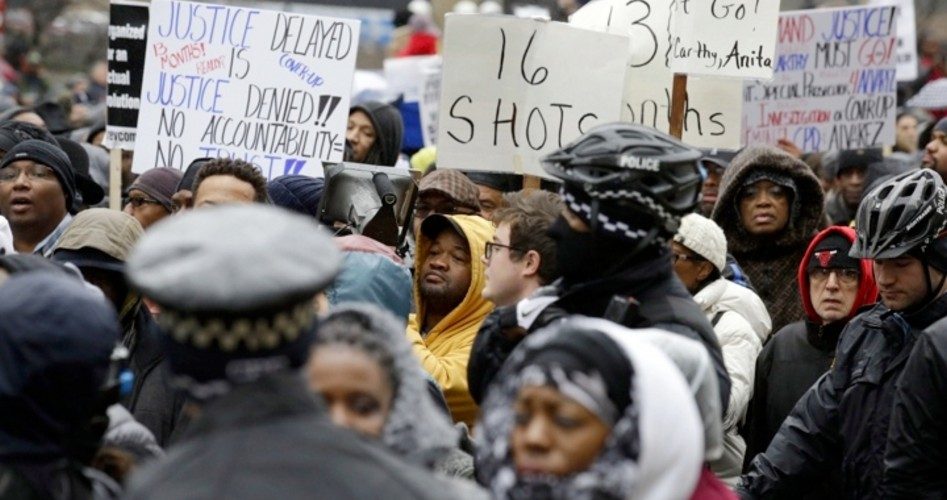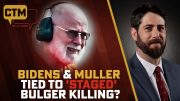
About 2,000 protesters descended on The Magnificent Mile — a major shopping area in Chicago — on Black Friday to protest the police shooting of 17-year-old Laquan McDonald. The protest, which was largely peaceful, disrupted businesses on the biggest shopping day of the year. The most common slogans chanted by the protesters were, “13 months, 16 shots” and “Stop the cover up, 16 shots.” There were demands for police reform and the “demilitarization” of the Chicago Police Department.
While many of the slogans used by protesters in the past — such as Ferguson’s famous “Hands Up, Don’t Shoot!” — were easily discredited, that was not the case with the recently released dashcam video of the shooting in Chicago. Officer Jason Van Dyke, within six seconds of arriving on the scene and exiting his vehicle, shot McDonald 16 times. The last 14 of those shots were fired as McDonald lay dead or dying in the street. And even though Cook County prosecutor Anita Alvarez has had the video since days after the shooting, she waited a full 400 days (or “13 months”) before charging the officer with first-degree murder.
In a previous article, this writer covered not only the dashcam video, but also both the similarities and differences in the accounts of the shootings in Ferguson and Chicago which happened within three months of each other. In the one case (Ferguson), the protesters ignored clear facts that showed the shooting was both justified and reasonable; in the other case (Chicago), the protesters have the facts on their side.
Unfortunately, while the protest was largely peaceful, the protesters, led by the “Reverand” Jesse Jackson, used tactics that infringe on the rights of others. In particular, the protesters impeded the property rights of business owners. As Reuters reported, “Groups of protesters locked arms to temporarily keep shoppers out of a few stores, but there were no major disruptions.” Reuters quoted John Curran, a vice-president of marketing for The Magnificent Mile Association, as saying, “The protesters did take over the street for sometime today blocking stores but it seems to have been a safe experience thus far.” Curran seems to have taken it in stride, though, adding, “In commerce terms you can think of this as a snow day. There is going to be a loss of revenue today and we plan to make that up during the rest of the holiday season.” Of course no amount of taking it stride justifies the abuse of property rights. These types of disruptive tactics are common whenever Jesse Jackson is involved.
Jackson and others have cast the shooting in terms of a racial issue: White cop shoots black teen; Racism must be at the root. While it may yet turn out that this is the case, nothing that is known so far supports jumping to that conclusion.
It is a little hard to swallow the idea that Chicago — as a city — has any real degree of “institutional racism.” Mayor Rahm Emanuel and Obama go back ages as liberal-left activists in Chicago. Though Emanuel’s administration has its corruption, to be sure, to protest the racial angle is simply ridiculous..
The protesters have demanded that Police Superintendent Garry McCarthy either resign or be fired. According to Reuters, “African-American members of the City Council” have also demanded his resignation. McCarthy defended his administration in a press conference, saying, “If people peel away the onion on what’s happening right now in the policing world, you’re going to find a police department that’s doing an exceptional job.”
The problem is that as people “peel away the onion,” they come across facts that do not show “a police department that’s doing an exceptional job.” Instead they see a police department that kept Jason Van Dyke on the payroll for “13 months” while the prosecutor delayed bringing charges against him. They find a police department that, after spending three hours viewing security camera footage from a Burger King on the same road as the shooting, cannot explain the fact that 86 minutes of that footage disappeared from all seven cameras. They watch the video and see that the accounts offered by Van Dyke and some other officers present during the shooting are pure fabrication. They see that beyond approaching the dead or dying teen to kick the knife from his hand, no one so much as checked on him during the duration of the time the video covers. These facts bear witness to “a police department that’s doing an exceptional job” trying to create and perpetrate a cover up. These facts are not comforting; they are damning.
In that same news conference, McCarthy spoke to the demands for his resignation, saying, “The mayor has made it very clear that he has my back.” It remains to be seen whether that will hold up under pressure.
What also remains to be seen is how Emanuel will use this crisis to further the federal takeover of local police departments, including his own. One thing is clear, though: While the abuse of power can occur at any level of government from city hall to the White House, the higher up the corruption, the more damage the corruption can do to the nation as a whole and the harder it will be to eliminate the corruption. If local police departments are nationalized under the pretext of eliminating what genuine police brutality does exist, the predictable result would not be less police brutality but more. In fact, supplanting local police forces responsible to the communities they are entrusted to protect and serve with a nationalized police force beholden to Washington would likely cause Americans to look back on today as the “good old days.”
When genuine police brutality actually occurs, it should be addressed at the local level. If city hall is corrupt, local citizens can clean house. And if sufficient evicence exists to charge a police officer with murder, as is the case with Chicago policeman Van Dyke, then the system should be allowed to work. That is, he should be tried in a courtroom, with a jury deciding if he is guilty beyond a reasonable doubt.
The New American and its parent organization, The John Birch Society, have been warning for decades against creating a national police force ostensibly to end alleged institutional racism and police brutality. For more information, see the magaizne’s special report on the subject by clicking here.
Photo: AP Images




